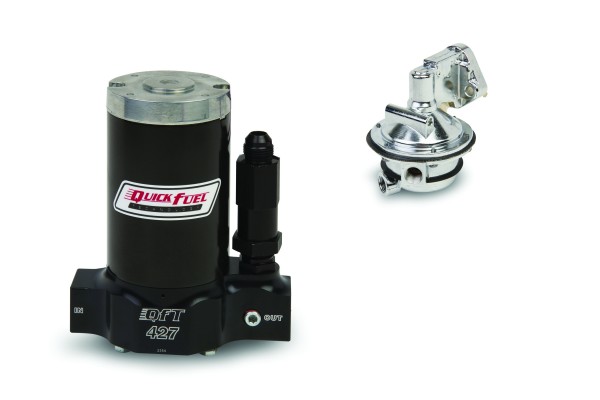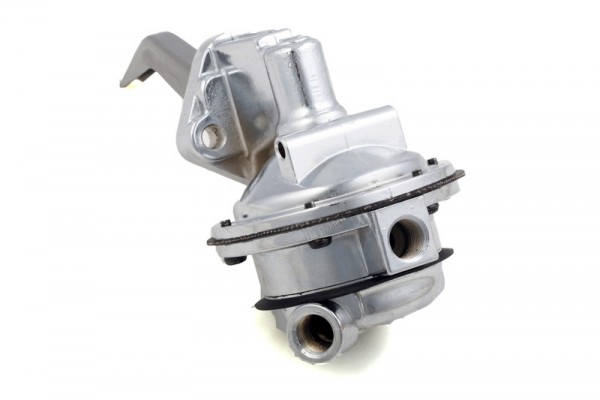In simpler times, carburetors relied on mechanical fuel pumps, and EFI engines required high-pressure electric pumps. Things aren’t so simple anymore because times have definitely changed. Even the most beastly of electric pumps can struggle to keep pace with today’s crop of 3,000-plus horsepower Outlaw and Pro Mod-style forced induction EFI engines. At this level, belt-driven mechanical pumps are very much the norm.
At the opposite end of the spectrum, the rise of late-model engine swaps has increased the popularity of electric fuel pumps at modest horsepower levels more typically associated with mechanical pumps. In between these two extremes, a typical street/strip application can make do with either an electric or a mechanical pump.
So which is right for your car?
Mechanical vs. Electric
Although mechanical and electric fuel pumps each have their share of pros and cons, sometimes it all comes down to practicality.
“The obvious advantages of a mechanical pump are that they don’t make any noise and they don’t require any additional plumbing or wiring. That’s a big plus,” said Zach Baker of Quick Fuel Technology. “However, these days we’re starting to see people swap carbureted GM LS motors, Ford mod motors, and even late-model big block Chevys into older muscle cars. Since these engines were fuel injected from the factory, they never came with bosses to mount a mechanical pump on the block. For these applications, QFT offers a line of small electric fuel pumps that are very quiet, reliable, and street friendly.”
QFT’s entry-level cast electric fuel pumps might be compact in size, but they can support up to 750 horsepower. Beyond that level, QFT recommends stepping up to a high-capacity billet electric pump. With flow ratings that range between 230 and 427 gallons-per-hour (GPH), QFT’s Pro Series pumps can support 800-2,500 horsepower. Impressive flow rates aside, optimizing fuel pump performance and reliability requires matching the right pump with the right application.
“All of our electric pumps that flow 175 GPH or less are very street friendly,” Baker said. “Our Pro Series pumps are designed for very demanding drag racing applications. Street use with these pumps should be very limited.”
Since different hot rodders interpret “very limited” in different ways, QFT has a simple piece of advice for those that like to push the envelope.
“These days it’s not uncommon for people to make over 1,000 horsepower,” Baker said. “At that power level with one of our Pro Series pumps, it’s fine to drive down to Sonic and grab a hamburger, but you definitely don’t want to drive across the country. Any of our pumps that flow 230-plus GPH are intended primarily for drag racing use.”
Enhancing Reliability
Even the best electric fuel pumps on the market aren’t very forgiving of poor installation practices. Fortunately, a little common sense goes a long way in maximizing pump reliability.
“Trying to run a $400 pump off of a $2 toggle switch isn’t going to work for very long. You always want to wire a pump through a relay,” Baker said. “Mount the pump close to the tank and lower than the fuel supply to ensure that it’s gravity-fed properly. Also, make sure to follow the manufacturer’s recommendation for fuel line sizing. Matching up a -12AN feed line with a -6AN return line isn’t going to work very well. All of our Pro Series pumps have -10AN inlets and outlets.”
Granted that the Pro Series’ billet aluminum construction enhances durability on the outside, each and every internal component has also been optimized to ensure reliability on the inside. Pro Series pumps utilize a proven six-vane design as well as epoxy-coated windings to extend motor life. The pump base is integrated into the bottom of the motor to improve pump seal and shaft alignment, and an integrated bypass valve eliminates pump cavitation while stabilizing fuel flow.
Equally important is the design of the basic pumping mechanism itself.
“Rotor and vane style pumps are very reliable and they have been around forever,” Baker said. “We prefer using it over a gerotor design because if you get a piece of sand or debris in a g-rotor pump, it’s done. The rotor and vane pumps that we use are bulletproof, and you could probably pump the water out of your basement with one of them.”








Can I use the QFT 175 to transfer diesel fuel from my auxiliary tank to my trucks standard tank and wire it to a switch on the dash
I have a 427 big block with 860 horsepower, Which electronic fuel pump would I need. Carburetor is Holley 1050 dual line double pumper.
Hey Terry, click here to contact Summit Racing–they’ll ask you some questions to make sure you’ll find exactly what pump you’ll need.